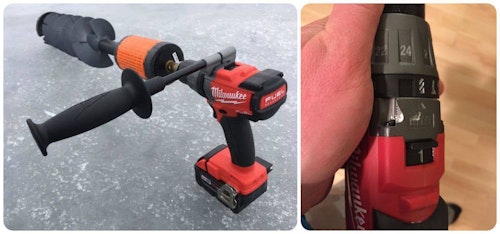
The author drilling holes with an 8-inch Eskimo Pistol Bit and a Milwaukee M18 Fuel cordless drill mounted to a Clam Drill Plate.
I made the conversion to a drill-powered ice auger a handful of years ago. If you haven’t used one, I highly recommend that you do so, especially for early and late in the winter fishing season when ice isn’t at its thickest point.
Note: I didn’t sell my gas-powered auger because when the ice is more than 18 inches thick, I find it more efficient to cut with gas power, and this difference is magnified when you need to punch more than a dozen holes. Even with two fully charged batteries for a drill, super-thick ice will eventually take its toll. A gas auger, however, will keep cutting, provided you brought enough fuel.
One downside to using a drill-powered ice auger is it can be difficult to hold while punching holes. This winter I discovered that the problem can be solved by adding a Clam Drill Plate (MSRP: $89.99) to your system.
As shown in the accompanying photos, you mount a brushless 18-volt cordless drill to the Drill Plate’s top, then the auger bit is secured to the Plate’s bottom . It doesn’t matter which brand or model cordless drill you currently own; the Plate works with them all.
A couple years ago while cutting ice with my cordless Milwaukee M18 Fuel drill, a piece of the mounting bracket broke where the side handle attaches (see photo below), which means I couldn’t use the side handle. This made it difficult — even a bit dangerous — to punch holes through the ice. That’s the reason I decided to finally try the Clam Drill Plate. What I discovered, however, is not only did the Plate eliminate the problem of holding my cordless drill safely, but I could also cut straighter holes. The Plate simply makes it easier to align everything up and avoid crooked holes.

In addition — and I have no explanation for this result except to say I’ve noticed it time and time again on the ice this winter — but I’m cutting more total holes (total ice inches) with each battery. It has to be tied to the fact I’m much more stable while punching holes with the Clam Drill Plate. With a better grip on the drill, better control of the auger speed, and cutting straighter holes, the entire system seems to work more efficiently.

A Word About Ice Auger Bits
I’ve used the Clam Drill Plate with two different auger bits, a 6-inch K-Drill (MSRP: $179), as well as an 8-inch Eskimo Pistol Bit (MSRP: $229.99). I’ve owned the K-Drill for a few years and it works very well, but when targeting big pike with tip-ups and large deadbaits (12-inch suckers), I had to cut two overlapping 6-inch holes, which was difficult. I found many outstanding reviews of the 8-inch Eskimo Pistol Bit online, so I decided to give it a try.
The Eskimo Pistol Bit weighs only 3.9 pounds and features a centering point to help it stay in place as you begin drilling, as well as two replaceable steel blades. An 8-inch hole is ideal for targeting big pike, and this fact surprised me: I’m able to punch just as many holes per battery with the 8-inch Eskimo Pistol Bit as I can with the 6-inch K-Drill.
The primary difference between the two ice auger bits is blade design. The K-Drill has a chipper-style blade system, which handles cutting old holes better than the more traditional blades found on the Pistol Bit. K-Drill blade sharpening is free for life of the product, which the company says is two or three sharpenings. A replacement set of K-Drill blades is $40 for 6 or 7.5 inches, and $45 for 8.5 inches.
The traditional blades of an Eskimo Pistol Bit can also be resharpened a couple times, and replacement blades are priced at $29.99 (6 inch or 8 inch). A new Ice Point is $19.99, but in my opinion this shouldn’t need replacement unless you break it. Note: Eskimo doesn’t offer blade resharpening; check with your local tackle shop for this service.







